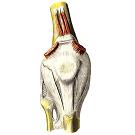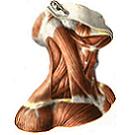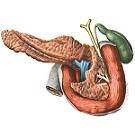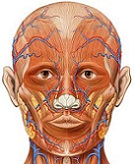The nasal cavity
The cavity of the nose , cavitas nasi, is divided by the septum nasi, septum nasi, into two almost symmetrical parts.
In the septum the nose is distinguished: membranous part, pars membranacea, cartilaginous part, pars cartilagines, and bone part, pars ossea.

Most of the cartilaginous part of the septum forms cartilaginous septa nasi cartilago, an irregular quadrangular plate. The posterior margin of the cartilage is wedged into the angle formed by the perpendicular plate of the trellis and the opener; The upper sections of this edge are attached to the anterior edge of the perpendicular plate, and the lower ones to the anterior edge of the perpendicular plate, and below to the anterior edge of the opener and to the anterior sections of the nasal crest of the horizontal plate of the palatine bone and the anterior nose of the upper jaw body.
The narrowest part of the cartilage is the posterior process (sphenoid bone), processus posterior (sphenoidalis). The anterior margin of the cartilage of the septum reaches the medial leg of the large cartilage of the wing of the nose, the anterior margin reaches the inner surface of the dorsum of the nose in the region of the seam between the nasal bones.
The base of the septum of the nose separating the nostrils was called the movable part of the septum of the nose, pars mobilis septi nasi.
In the nasal cavity, the vestibule of the nasal cavity is distinguished, vestibulum nasi, covered from the inside by the skin of the nasal cavity, and the cavity of the nose, cavitas nasi, lined with mucous membrane.
The threshold of the nasal cavity, vestibulum nasi, separates from its own nasal cavity a small protrusion - the threshold of the nasal cavity, limen nasi, formed by the upper edge of the lateral pedicle of the large cartilage of the wing of the nose.

In the anterior parts of the nasal cavity, there is a slight protrusion - the nasal cushion, agger nasi. It follows from the front end of the middle shell to the threshold of the nasal cavity. A vestibule of the middle course, atrium meatus medii, lies behind the nasal shaft.
The nasal cavity is divided into paired nasal passages. The upper nasal passage, the taatus nasi superior, is confined to the upper and middle nasal shells. The middle nasal passage, meatus nasi medius, is enclosed between the middle and lower nasal shells. The lower nasal passage, meatus nasi inferior, is located between the inferior nasal cavity and the lower wall of the nasal cavity. The common nasal passage is located between the medial surfaces of the nasal concha and the septum of the nose. The part of the nasal cavity lying behind the posterior ends of the nasal concha is called the nasopharyngeal passage, meatus nasopharyngeus.
The surrounding nasal cavity of the bone is airborne and contains paranasal sinuses, sinus paranasales. The latter are associated with the nasal passages: the maxillary sinus, sinus maxillaris, frontal sinus, sinus frontalis, middle and anterior cells of the lattice, cellulae ethmoidales mediales et anteriores, - with the median nasal passage through the trellis funnel, infundibulum ethmoidale, and the semilunar cleft, hiatus semilunaris; Posterior cells of the lattice, cellulae ethmoidalis posteriores, - with the superior nasal passage and the sphenoid sinus, sinus sphenoidalis, - with a common nasal passage at the level of the upper passage through the aperture of the sphenoid sinus, apertura sinus sphenoidalis.
In the lower nasal passage opens the nasolacrimal duct, ductus nasolacrimalis, bounded by a lacrimal fold, plica lacrimalis, a lacrimal membrane.
Under the mucosa of the lower wall of the anterior section of the common nasal passage, 1.5-2.0 cm posterior to the nostrils, is the upper opening of the incisive canal, canalis incisiuus, containing vessels and nerve.
Accordingly, the posterior end of the middle nasal shell under the mucous membrane has a wedge-palatal opening, foramen sphenopalatinum, through which the vessels and nerves pass to the mucosa of the nasal cavity.

In the anterior parts of the nasal cavity, the mucous membrane is the continuation of the skin cover of the nasal cavity gradually shifting into it; In the posterior sections the mucosa through the back holes of the nose - the choana, choanae, passes into the mucous membrane of the pharynx and the soft palate.
In the mucosa of the nasal cavity, as well as the ocelli sinuses are mucous glands, the size, shape and number of which are different in different parts of the nasal cavity. Especially many glands lie in the mucous membrane of the respiratory region of the nose - these are the nasal glands, glandulae nasales.
In the submucosa, a large number of blood and lymphatic vessels pass, while in the middle and lower shells there is a dense network of small vessels that form the cavernous venous plexus of shells, plexus cavernosi concharum. In the anterior parts of the cartilaginous nasal septum on the mucosa, behind and above the canalis incisivus, canalis incisivus, there is sometimes a small opening leading to the blindly terminating forward channel - the vomer-nasal organ, organum vomeronasale. On the lateral side it is limited by the vomer-nasal cartilage, cartilago vomeronasalis.
Isolated in the mucous membrane of the nasal cavity are the respiratory and olfactory regions. A part of the nasal mucosa lining the upper shells and free, facing the septum of the side of the middle shells, as well as the corresponding upper part of the septum of the nose, belongs to the olfactory region, regio olfactoria. In the mucous membrane of this region there are also endings of the olfactory nerves, nn. Olfactorii. The rest of the mucosa of the nasal cavity is included in the respiratory region, regio respiratoria.
Innervation: mucous membrane of anterior part - n. Ethmoidalis anterior (from n. Nasociliaris) and rr. Nasales interni (from n. Infraorbitalis); Rear division - n. Nasopalatinus and rr. Nasales posterior, superior et inferior (branches of ganglion pterygopalatinum n. Maxillaris).
Blood supply: a. Sphenopalatina (from a. Maxillaris), aa. Ethmoidales anterior and posterior (from a. Ophtalmica).
Venous blood flows from the nasal mucosa along v. Sphenopalatina in the plexus pterygoideus. Lymphatic vessels from the nasal mucosa are suitable for nodi lymphalici submandibulares and submentales.









Comments
When commenting on, remember that the content and tone of your message can hurt the feelings of real people, show respect and tolerance to your interlocutors even if you do not share their opinion, your behavior in the conditions of freedom of expression and anonymity provided by the Internet, changes Not only virtual, but also the real world. All comments are hidden from the index, spam is controlled.